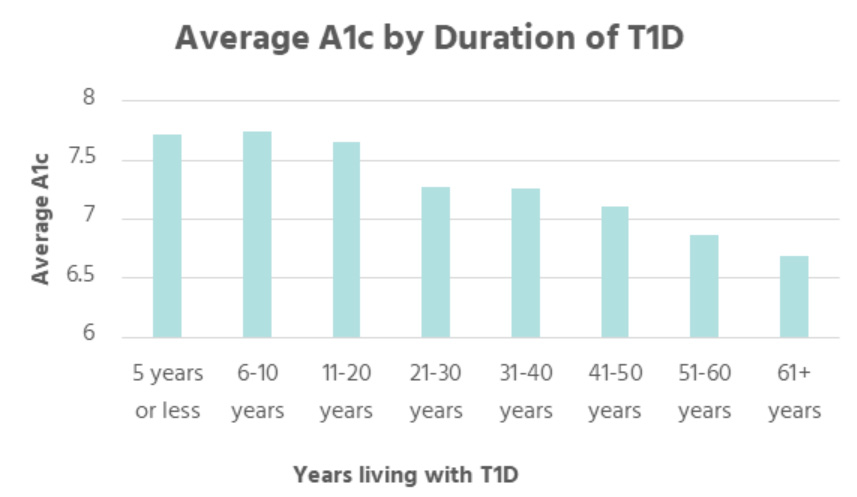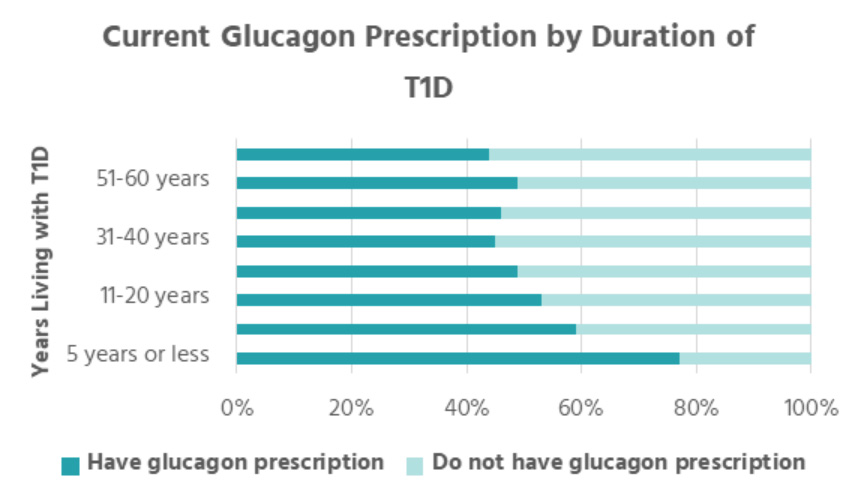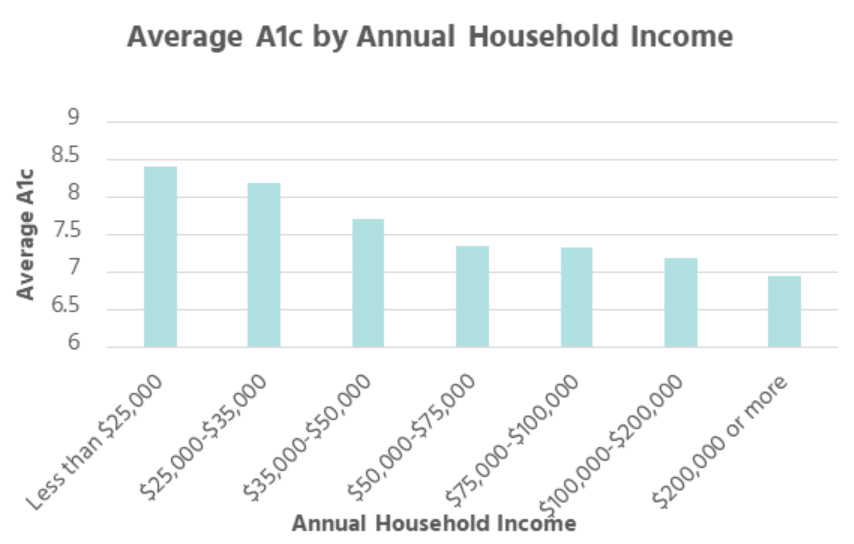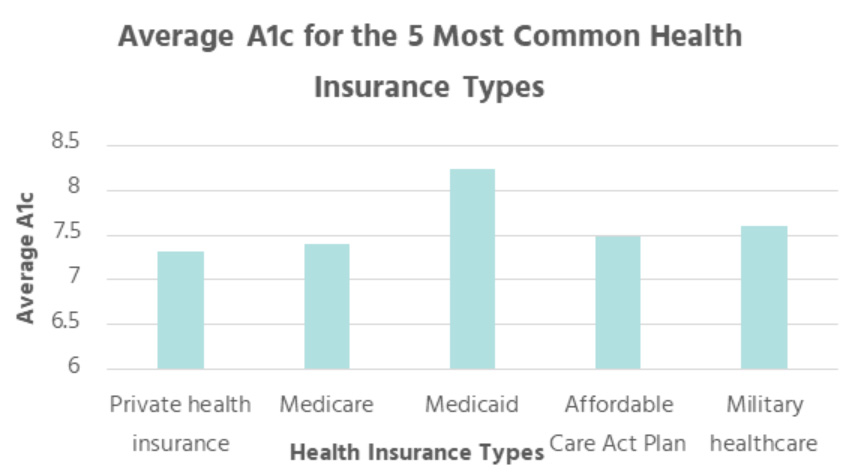
Sign up for a new account.
And get access to
The latest T1D content
Research that matters
Our daily questions
Sign up by entering your info below.
Reset Your Password
Don't worry.
We will email you instructions to reset your
password.
We’re continuing to celebrate 2 years of the T1D Exchange Registry!
In honor of our 2nd anniversary, we’re sharing insights from the Registry! View more insights from our first article in this series and follow along on social media!
Not already part of the T1D Exchange Registry? Join us!
In part 2 of our Registry insights campaign, we’re looking at how duration of type 1 diabetes (T1D) and socioeconomic factors impact health outcomes, including:
- Average A1c by duration of T1D
- Current glucagon prescription by duration of T1D
- Average A1c by annual household income
- Average A1c for the 5 most common health insurance types in the Registry

In the Registry, what is the average A1c for groups of people who have lived with T1D for different lengths of time?
- T1D for 5 years or less: 7.72%
- T1D for 6-10 years: 7.74%
- T1D for 11-20 years: 7.66%
- T1D for 21-30 years: 7.27%
- T1D for 31-40 years: 7.26%
- T1D for 41-50 years: 7.11%
- T1D for 51-60 years: 6.87%
- T1D for 61+ years: 6.69%
People who have lived with T1D for 10 years or fewer have the highest average A1cs around 7.7%. The average A1c gradually drops over the next decade before a more drastic drop in the age group living with T1D for 21-30 years. The difference between the A1cs of the people diagnosed most recently and the people living with T1D for the longest is 1%.
The average continues to fall as the years of experience with T1D increases.

In the Registry, what percentage of people who have had T1D for different lengths have a current glucagon prescription?
- T1D for 5 years or less: 76.6%
- T1D for 6-10 years: 58.8%
- T1D for 11-20 years: 52.8%
- T1D for 21-30 years: 48.9%
- T1D for 31-40 years: 44.7%
- T1D for 41-50 years: 45.6%
- T1D for 51-60 years: 49.2%
- T1D for 61+ years: 44.4%
People in the Registry who have been living with T1D for 5 years or less are much more likely to have a current glucagon prescription than those who have been living with T1D for longer.
For all groups in the Registry who have lived with T1D for more than 20 years, less than half of participants have a current prescription for glucagon.

In the Registry, what is the average A1c of people in different annual household income brackets?
- Less than $25,000: 8.41%
- $25,000 – $35,000: 8.19%
- $35,000 – $50,000: 7.71%
- $50,000 – $75,000: 7.36%
- $75,000 – $100,000: 7.34%
- $100,000 – $200,000: 7.19%
- $200,000 or more: 6.95%
According to this Registry data, there is a steady decline in average A1c as annual household income increases. The difference in average A1c between the lowest income group and the highest income group is 1.46%.
There are many factors that contribute to how income levels can impact glycemic outcomes, particularly the ability to afford insulin and T1D management tools. As noted in the previous Registry insights article, people who use an insulin pump and/or CGM are more likely to reach target blood glucose levels, and the cost of these devices can be a barrier for lower income groups.

In the Registry, what is the average A1c for people with 5 of the most common health insurance types?
- Private Health Insurance: 7.32%
- Medicare: 7.41%
- Medicaid: 8.24%
- Affordable Care Act (ACA) plan: 7.48%
- Military healthcare: 7.61%
Of the 5 most frequently reported health insurance types in the Registry, people with T1D covered by private health insurance plans have the lowest average A1c at 7.32%, whereas people covered by Medicaid had the highest average A1c of 8.24%.
This difference of 0.92% may seem insignificant, but as recent T1D Exchange studies have shown, publicly insured people with T1D were more likely to have adverse outcomes from COVID-19 and are less likely to meet glycemic targets than those with private insurance.
Be sure to check out more insights in our previous article and on Instagram (@T1DExchange)!
And if you haven’t already, join the T1D Exchange Registry today and add your story to ours!
All data presented above is only representative of participants in the T1D Exchange Registry. This data does not indicate any causation in its current format, but rather presents the Registry data as it exists in June 2021.
Sarah Howard
Related Stories
4 Comments
T1D Exchange Registry: What We’ve Learned over the Last 2 Years Cancel reply
You must be logged in to post a comment.








“publicly insured people with T1D were more likely to have adverse outcomes from COVID-19 and are less likely to meet glycemic targets than those with private insurance.”.
The missing information here is the A1c of those withOUT insurance. Public insurance is the only option for some people so it’s lower performance is still better than no insurance. Yet, public options still should work to improve those numbers.
Hi Karen – thanks for your suggestion! We agree that this would be interesting to include in future Registry data analysis. The next time we share insights from the Registry, we’ll be sure to look into this!
Wow. I’m rather floored and somewhat dismayed by the averages here. 🙁 My daughter was dx in 2011 – 10 years ago. Her A1C is 5.6%. A majority of the 10 years since her dx, she stayed around the 6.2% – 6.8% range. Tandem’s Control IQ has tightened it up considerably. And she’s NOT low carb by any stretch of the imagination. She’s more carb-junkie than carb-avoider.
This report makes me sad. :'(
Good reporting. It’s hard to represent complex data and data interactions. 🌈🎉🌋